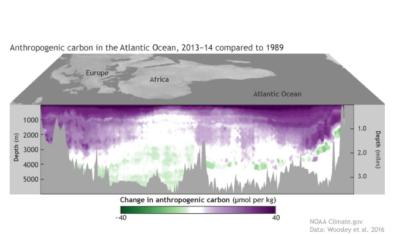Science Source
Anthropogenic ocean acidification over the twenty-first century and its impact on calcifying organisms
- States that today's surface ocean is saturated with respect to calcium carbonate, but increasing atmospheric carbon dioxide concentrations are reducing ocean pH and carbonate ion concentrations, and thus the level of calcium carbonate saturation
- Experimental evidence suggests that if these trends continue, key marine organisms—such as corals and some plankton—will have difficulty maintaining their external calcium carbonate skeletons
- Uses 13 models of the ocean–carbon cycle to assess calcium carbonate saturation under the IS92a ‘business-as-usual’ scenario for future emissions of anthropogenic carbon dioxide
- Projections indicate that Southern Ocean surface waters will begin to become undersaturated with respect to aragonite, a metastable form of calcium carbonate, by the year 2050
- Finds that by 2100, this undersaturation could extend throughout the entire Southern Ocean and into the subarctic Pacific Ocean
- Exposes live pteropods to the predicted level of undersaturation during a two-day shipboard experiment and finds that their aragonite shells showed notable dissolution
- Findings indicate that conditions detrimental to high-latitude ecosystems could develop within decades, not centuries as suggested previously
Related Content
Headline

Jun 6, 2018 | NOAA Climate.gov
Cruises cut a slice through the Atlantic's carbon pie
Science Source
| Nature Climate Change
Detecting regional anthropogenic trends in ocean acidification against natural variability
T. Friedrich, A. Timmermann, A. Abe-Ouchi et al
Science Source
| Biogeosciences
Using present-day observations to detect when anthropogenic change forces surface ocean carbonate chemistry outside preindustrial bounds
Sutton, Adrienne J., Sabine et al
Science Source
| Estuaries and Coasts
Is Ocean Acidification an Open-Ocean Syndrome? Understanding Anthropogenic Impacts on Seawater pH
Carlos M. Duarte, Iris E. Hendriks, Tommy S. Moore et al


